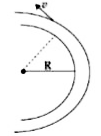A car of mass m is moving on a level circular track of radius R if μs represents the static friction between the road and tyres of the car, the maximum speed of the car in circular motion is given by.
√Rg/μs
√mRg/μs
√μsRg
√μsmRg
The correct Answer is:C
μmg≥mv2R
v≤√μRg
vmax=√μRg
Topper's Solved these Questions
- BOOK - NEET PREVIOUS YEAR (YEARWISE + CHAPTERWISE)CHAPTER - NEETEXERCISE - QUESTION95videos
NEET
- BOOK - NEET PREVIOUS YEAR (YEARWISE + CHAPTERWISE)CHAPTER - NEETEXERCISE - MCQ95videos
NEET
- BOOK - NEET PREVIOUS YEAR (YEARWISE + CHAPTERWISE)CHAPTER - NEETEXERCISE - MCQ95videos
NEET
- BOOK - NEET PREVIOUS YEAR (YEARWISE + CHAPTERWISE)CHAPTER - MOTION IN TWO AND THREE DIMENSIONEXERCISE - All Questions47videos
MOTION IN TWO AND THREE DIMENSION
- BOOK - NEET PREVIOUS YEAR (YEARWISE + CHAPTERWISE)CHAPTER - NEET 2020EXERCISE - All Questions45videos
NEET 2020
Similar Questions
A car has to move on a level turn of radius 45 m. If the coefficient of static friction between the tire and the road is μs=2.0, find the maximum speed the car can take without skidding.
View SolutionA car of maas M is moving on a horizontal circular path of radius r. At an instant its speed is v and is increasing at a rate a.
View Solution
Knowledge Check
- Question 1 - Select One
A 100kg car is moving with a maximum velocity of 9m/s across a circular track of radius 30 m . The maximum force of friction between the road and the car is
A1000NB706NC270ND200N - Question 2 - Select One
A car is taking turn on a circular path of radius R. If the coefficient of friction between the tyres and road is μ, the maximum velocity for no slipping is
AμRgB2μRgC(μRg)1/2D(2μRg)1/2 - Question 3 - Select One
A car of mass 1000 kg moves on a circular track of radius 20 m . If the coefficient of friction is 0.64, then the maximum velocity with which the car can move is
A22.4 m/sB5.6 m/sC11.2 m/sD6.5 m/s
A modern gran -prix racing car of masses m is travelling on a flat track in a circular arc of radius R with a speed v. If the coefficient of static friction between the tyres and the track is μs, then the magnitude of negative lift FL acting downwards on the car is : ( Assume forces on the four tyres are identical and g = acceleration due to gravity )
 View Solution
View SolutionA car is moving on a horizontal circular track of radius 0.2 km with a constant speed. If coefficient of friction between tyres of car and road is 0.45, then maximum speed of car may be [Take g=10m/s2]
View SolutionFind the maximum velocity for skidding for a car moved on a circular track of radius 100 m . The coefficient of friction between the road and tyre is 0.2
View SolutionA car of mass 800 kg moves on a circular track of radius 40 m . If the coefficient of friction is 0.5, then maximum velocity with which the car can move is
View SolutionA car of mass 1000 kg moves on a circular track of radius 20 . If the coefficient of friction is 0.64, then the maximum velocity with which the car can move is
View Solution

